Multi-Cloud Networking Market Size and Share Forecast Outlook From 2025 to 2035
The multi-cloud networking market is advancing rapidly, driven by enterprises’ growing need for agility, scalability, and optimized performance across diverse cloud environments. As organizations adopt hybrid and multi-cloud architectures to enhance flexibility and resilience, networking solutions that enable seamless interconnectivity and security have gained prominence.
The current market landscape is characterized by a strong emphasis on automation, workload mobility, and integrated management frameworks that reduce operational complexity. Cloud-native technologies and API-driven platforms are further accelerating adoption among data-intensive industries.
The rising prevalence of remote work and distributed applications has also heightened demand for secure and high-performance connectivity solutions. With digital transformation initiatives expanding globally, the market is expected to continue its upward trajectory, supported by strategic collaborations among cloud providers and networking vendors..
Quick Stats for Multi-Cloud Networking Market
- Multi-Cloud Networking Market Industry Value (2025): USD 5.2 billion
- Multi-Cloud Networking Market Forecast Value (2035): USD 17.2 billion
- Multi-Cloud Networking Market Forecast CAGR: 12.8%
- Leading Segment in Multi-Cloud Networking Market in 2025: Solution (68.5%)
- Key Growth Region in Multi-Cloud Networking Market: North America, Asia-Pacific, Europe
- Top Key Players in Multi-Cloud Networking Market: Cisco Systems, Inc., Juniper Networks, Inc., Hewlett Packard Enterprise Development LP, Akamai Technologies, VMware Inc., F5, Inc., Citrix Systems Inc, Nutanix, Cloudflare, Inc., Oracle
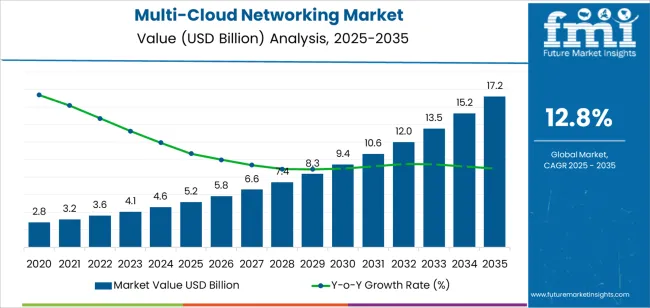
| Metric |
Value |
| Multi-Cloud Networking Market Estimated Value in (2025 E) |
USD 5.2 billion |
| Multi-Cloud Networking Market Forecast Value in (2035 F) |
USD 17.2 billion |
| Forecast CAGR (2025 to 2035) |
12.8% |
Segmental Analysis
The market is segmented by Component, Enterprise Size, Deployment Mode, and Industry Vertical and region. By Component, the market is divided into Solution and Services. In terms of Enterprise Size, the market is classified into Large Enterprise and Small And Medium. Based on Deployment Mode, the market is segmented into Public Cloud and Private Cloud. By Industry Vertical, the market is divided into BFSI, IT And Telecom, Retail And E-Commerce, Healthcare, Manufacturing, Energy And Utilities, Media And Entertainment, and Others. Regionally, the market is classified into North America, Latin America, Western Europe, Eastern Europe, Balkan & Baltic Countries, Russia & Belarus, Central Asia, East Asia, South Asia & Pacific, and the Middle East & Africa.
Insights into the Solution Segment
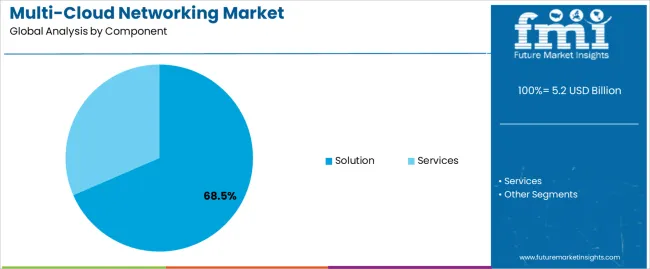
The solution segment leads the component category, accounting for approximately 68.50% share of the multi-cloud networking market. This dominance is attributed to enterprises’ increasing reliance on integrated platforms that provide unified control over networking, security, and performance management across multiple cloud environments.
Solutions offering automation, visibility, and orchestration capabilities have become critical for optimizing resource utilization and minimizing downtime. The segment benefits from accelerated adoption of SaaS and IaaS models, where seamless data exchange and policy enforcement are essential.
Vendors are focusing on developing AI-driven analytics and zero-trust frameworks to enhance network intelligence and threat mitigation. With enterprises prioritizing operational efficiency and secure connectivity, the solution segment is expected to maintain its leadership throughout the forecast horizon..
Insights into the Large Enterprise Segment
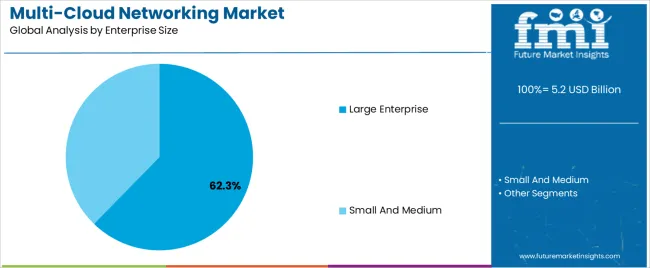
The large enterprise segment dominates the enterprise size category, representing approximately 62.30% share of the market. This dominance arises from the complex networking requirements of multinational organizations operating across multiple regions and cloud environments.
Large enterprises are increasingly deploying multi-cloud strategies to avoid vendor lock-in and improve workload distribution. Investments in advanced networking infrastructure and security frameworks enable better control over data governance and performance optimization.
The segment also benefits from the growing integration of DevOps and cloud management tools that streamline operations. With sustained digital transformation budgets and focus on hybrid IT infrastructure, large enterprises are expected to remain the primary revenue contributors in this market..
Insights into the Public Cloud Segment
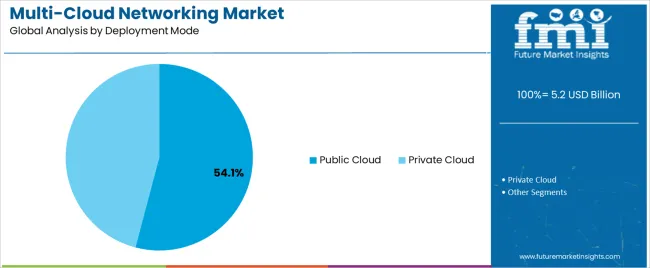
The public cloud segment holds approximately 54.10% share within the deployment mode category, supported by its scalability, cost-effectiveness, and ease of deployment. Enterprises increasingly leverage public cloud environments to host applications and workloads that require flexible scaling and global accessibility.
The segment benefits from continuous expansion of hyperscale data centers and advancements in software-defined networking that simplify multi-cloud integration. Service providers are enhancing interoperability through open APIs and cross-cloud connectors, facilitating seamless workload migration.
As enterprises continue to balance performance, cost, and compliance, public cloud networking will remain a strategic enabler of multi-cloud ecosystems, ensuring sustained segment dominance..
Consumption Trends Shaping the Multi-Cloud Networking Market
- Multi-cloud networking is becoming increasingly popular as more organizations adopt multi-cloud strategies.
- The trend towards multi-cloud is driven by recognizing the benefits of leveraging multiple cloud service providers, including enhanced agility, scalability, and resilience.
- Organizations looking to optimize their cloud infrastructure and applications increasingly rely on robust multi-cloud networking solutions.
- Multi-cloud networking solutions enable efficient deployment, monitoring, and management of network resources across disparate cloud platforms.
- The demand for multi-cloud networking solutions is fueled by the need for agility, innovation, and regulatory compliance, driving widespread adoption across industries.
- Multi-cloud networking solutions facilitate seamless integration with DevOps processes and ensure scalability and performance across distributed cloud environments.
- The multi-cloud networking market is experiencing rapid growth as organizations recognize the value of leveraging multiple cloud providers to optimize their cloud strategy and drive business success.
Factors Restraining the Growth of the Multi-Cloud Networking Market
The multi-cloud networking market is anticipated to surpass a global valuation of USD 17.2 billion by 2035, with a growth rate of 22.8% CAGR.
While the multi-cloud networking market is experiencing growth, several restraining factors can adversely affect its development and expansion.
- Interoperability is a significant challenge in the multi-cloud networking market due to the diverse nature of cloud environments and the need for standardized protocols.
- Organizations need help integrating and managing resources seamlessly across multiple clouds.
- Security concerns are a major hurdle in adopting multi-cloud networking solutions. Data privacy, compliance, and cloud security posture management are critical issues organizations face when securing data and applications in a distributed cloud environment.
- The complexity of multi-cloud networking architectures is a barrier to market growth. A need for more skilled professionals proficient in managing and optimizing these environments poses a challenge.
- Highly regulated industries face regulatory compliance requirements and data sovereignty concerns, making multi-cloud deployments more complicated and leading to hesitation among organizations.
- Vendor lock-in risks and the associated challenges of migrating workloads between cloud providers deter organizations from fully embracing multi-cloud networking solutions, impacting market expansion.
- The need for standardized processes and tools in multi-cloud networking solutions makes it difficult for organizations to manage and optimize these environments.
- The multi-cloud networking market faces significant challenges due to the need for clarity on pricing models, service-level agreements, and other commercial terms. This leads to confusion and hinders adoption.
Multi-Cloud Networking Industry Analysis by Top Investment Segments
The ability of Solution Components to seamlessly Integrate, Manage, and Orchestrate Network Resources across multiple Cloud Platforms
Based on their component type, the solution dominates the global multi-cloud networking market with an annual growth of 22.6% CAGR. This rising popularity is attributed to:
- Solution components provide centralized management consoles, orchestration capabilities, and advanced networking features, enabling organizations to efficiently deploy and manage complex multi-cloud architectures.
- With the increasing complexity and scale of multi-cloud environments, solution components offer a robust networking solution that can address diverse use cases and requirements.
- Solution components provide various functionalities such as virtual private networks, software-defined networking, load balancing, and security services.
- Solution components help organizations optimize network performance, enhance security, and ensure compliance across their multi-cloud deployments by offering a comprehensive suite of features and capabilities.
| Attributes |
Details |
| Component Type |
Solution |
| CAGR (2025 to 2035) |
22.6% |
Extensive IT Infrastructure and Diverse Business Operations of Large Enterprise
Large enterprises dominate the global multi-cloud networking market based on enterprise size with an annual growth of 22.4% CAGR. This rising popularity is attributed to:
- Large enterprises have the budget and purchasing power to invest in comprehensive multi-cloud networking solutions from leading vendors, which offer advanced features and functionalities tailored to meet their demanding requirements.
- Large enterprises prioritize reliability, performance, and scalability when selecting multi-cloud networking solutions.
- Large enterprises have dedicated IT teams with the expertise and experience to effectively deploy and manage complex multi-cloud networking architectures.
- Large enterprises' combination of greater complexity, larger budgets, and dedicated IT resources positions them as the dominant players in the multi-cloud networking market.
| Attributes |
Details |
| Enterprise Size |
Large Enterprise |
| CAGR (2025 to 2035) |
22.4% |
Analysis of Top Countries, Deploying and Managing Multi-Cloud Networking Solutions
The section analyzes the global multi-cloud networking market by country, including the United States, the United Kingdom, China, Japan, and South Korea. The table presents the CAGR for each country, indicating the expected market growth in that country through 2035.
| Countries |
CAGR |
| The United States |
22.9% |
| The United Kingdom |
23.7% |
| China |
23.6% |
| Japan |
24.2% |
| South Korea |
25.0% |
South Korea Values Cloud Tech for Innovation and Competition Edge
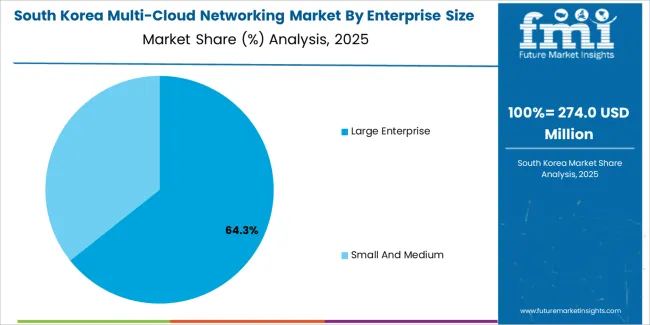
South Korea is the leading Asian country in the global multi-cloud networking market. The South Korean market is anticipated to register a CAGR of 25.0% through 2035.
- The Korean government is taking initiatives to promote digitalization and invest in advanced infrastructure, which will further fuel the adoption of multi-cloud networking solutions across various industries.
- South Korea's highly skilled workforce and favorable business environment also contribute to the growth of the multi-cloud networking market.
The United States advanced its digital infrastructure and widespread adoption of cloud technologies
The United States dominates the global multi-cloud networking market in North America. It is expected to exhibit an CAGR of 22.9% until 2035.
- The increasing frequency of severe weather events and natural disasters prompts organizations to invest in resilient networking solutions, including multi-cloud architectures, to ensure business continuity and disaster recovery capabilities.
- The United States’ highly competitive business environment also fuels the adoption of multi-cloud networking solutions as companies seek to leverage the latest technologies to gain a competitive edge in the market
The United Kingdom seeks Competitiveness and Prioritizes Digital Transformation.
The United Kingdom global multi-cloud networking market is predicted to register a CAGR of 23.7% through 2035.
- The United Kingdom government's focus on promoting innovation and technology adoption fosters a favorable environment for adopting multi-cloud networking solutions, driving market expansion.
- The United Kingdom's highly skilled workforce and advanced IT infrastructure further contribute to the growth of the multi-cloud networking market.
China's rapid Economic Growth and Industrialization
China’s multi-cloud networking market is anticipated to register a CAGR of 23.6% through 2035.
- As businesses seek to modernize their IT infrastructure and improve operational efficiency, the adoption of cloud technologies is on the rise.
- China’s government's initiatives to promote cloud computing and digital transformation initiatives in various sectors contribute to the growth of the multi-cloud networking market in the country.
- China’s large population and vast market potential also present significant growth opportunities for multi-cloud networking solution providers.
Japan's Strong Technological Innovation and Resilience in the Face of Natural Disasters
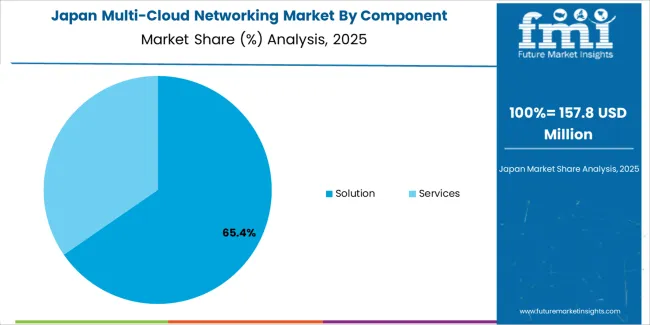
Japan’s multi-cloud networking industry is anticipated to register a CAGR of 24.2% through 2035.
- Japanese organizations prioritize adopting multi-cloud networking solutions to enhance disaster recovery capabilities and ensure business continuity during disruptions.
- Japan's highly skilled workforce and advanced technology infrastructure make it an attractive market for multi-cloud networking solution providers.
Key Players and Market Concentration in the Multi-Cloud Networking Industry
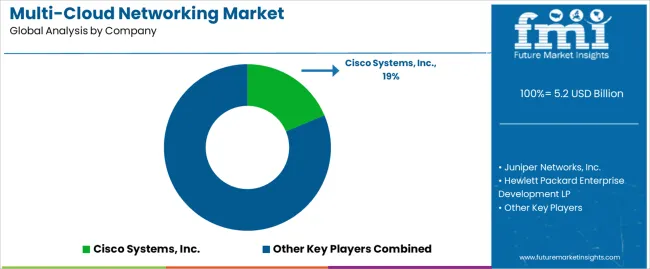
Leading companies in the multi-cloud networking industry are investing in research and development to provide advanced multi-cloud networking solutions that cater to the changing needs of businesses worldwide. They are also forming strategic partnerships and collaborations with cloud service providers, technology vendors, and system integrators to offer comprehensive solutions that integrate seamlessly with leading cloud platforms.
Manufacturers are committed to delivering exceptional customer experiences through tailored solutions, support services, and training programs, which help them build customer loyalty and drive long-term growth in the global multi-cloud networking market.
Recent Developments:
- On February 8th, 2025, Verizon Business introduced a multi-cloud management solution to its network-as-a-service offering. Duncan, an accomplished editor with over 20 years of experience in tech journalism, has led various publications, including Arabian Computer News and Computer Business Review, showcasing his expertise in the field.
- On December 21, 2025, Cisco Security Cloud integrated Isovalent's cloud-native networking products, known for leveraging Linux kernel utilities to automate multi-cloud network security and observability. Isovalent, the commercial supporter of open-source projects Cilium and Tetragon, became part of Cisco for enhanced cloud-native network security solutions.
- On January 3, 2025, Cisco acquired Isovalent, an open-source cloud-native networking and security solutions provider, to enhance its multi-cloud networking capabilities. This acquisition strengthened Cisco's position in delivering secure networking services across various public cloud environments.
- On May 8, 2025, Kyndryl and Cloudflare collaborated to introduce a multi-cloud networking service, including Cloudflare's zero-trust security solutions for Kyndryl customers. Executives from both companies informed CRN about the partnership, enhancing networking capabilities and security options for clients.
Leading Providers in the Global Multi-Cloud Networking Market
- Juniper Networks, Inc.
- Hewlett Packard Enterprise Development LP
- Akamai Technologies
- VMware Inc.
- F5, Inc.
- Citrix Systems Inc
- Nutanix, F5, Inc.
- Cisco Systems, Inc.
- Cloudflare, Inc.
- Oracle
Key Shifting Preferences Covered in the Multi-Cloud Networking Market Report
- Global Multi-Cloud Networking Vendors
- Prominent Multi-Cloud Networking Software
- Competitive Analysis of Strategies Used By Gartner, F5, Amazon Web Services, Microsoft Azure, Terraform, Kubernetes, And Google Cloud Platform (GCP)
- Multi-Cloud Network Connectivity Methods
- Advantages Of Multi-Cloud Networking Over Hybrid Cloud Networking
- Information About Multi-Cloud Network Architecture
Top Segments Studied in the Multi-Cloud Networking Market
By Component:
By Enterprise Size:
- Large Enterprise
- Small and Medium
By Deployment Mode:
- Public Cloud
- Private Cloud
By Industry Vertical:
- BFSI
- IT and Telecom
- Retail and E-Commerce
- Healthcare
- Manufacturing
- Energy and Utilities
- Media and Entertainment
- Others
By Region:
- Asia Pacific
- Europe
- North America
- Middle East & Africa
- Latin America
Frequently Asked Questions
How big is the multi-cloud networking market in 2025?
The global multi-cloud networking market is estimated to be valued at USD 5.2 billion in 2025.
What will be the size of multi-cloud networking market in 2035?
The market size for the multi-cloud networking market is projected to reach USD 17.2 billion by 2035.
How much will be the multi-cloud networking market growth between 2025 and 2035?
The multi-cloud networking market is expected to grow at a 12.8% CAGR between 2025 and 2035.
What are the key product types in the multi-cloud networking market?
The key product types in multi-cloud networking market are solution and services.
Which enterprise size segment to contribute significant share in the multi-cloud networking market in 2025?
In terms of enterprise size, large enterprise segment to command 62.3% share in the multi-cloud networking market in 2025.













